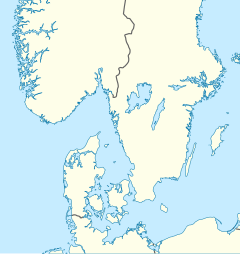Kontiskan
Location of the converter stations of the Kontiskan |
Kontiskan (also Konti-Skan ) is the name of two high-voltage direct current transmission systems (HVDC) between Denmark and Sweden . The KontiSkan 1, built in 1965, has an output of up to 250 MW at an operating voltage of 250 kV, the KontiSkan 2, built in 1988, has an output of 300 MW at a voltage of 285 kV. The two HVDC KontiSkan are jointly operated by Svenska kraftnät and Energinet.dk .
While the HVDC KontiSkan 1 still used mercury vapor rectifiers as converter valves in the converter station until 2006 , the HVDC KontiSkan 2 used thyristors for this - like all modern HVDC systems - from the start .
On the Danish side, the converter stations of the HVDC Konti-Skan 1 and 2 are in the immediate vicinity in Vester Hassing near Aalborg . A 34-kilometer-long, two-pole overhead line with the high-voltage poles of Konti-Skan 1 and Konti-Skan 2 leads from Vester Hassing to the beginning of the cable at Stensnäs on the Danish coast, while two 27-kilometer underground cables carry the electricity to the other poles of Konti-Skan 1 and 2 to the grounding electrode in Söra. A special feature of this line is that it is only equipped with an earth wire near the converter station and the cable terminal in Stensnäs .
The 23-kilometer submarine cable connection to the Danish island of Læsø begins in Stensnäs . This cable connection consists of three parallel cables, each with two sub-conductors with a copper cross-section of 310 square millimeters. One of these cables is used by the KontiSkan 1 and one by the KontiSkan 2. With the third cable, one part of the conductor is used by the KontiSkan 1 and the other by the KontiSkan 2.

The KontiSkan crosses the island of Læsø with a 17 kilometer long two-pole overhead line . A single-pole copper cable with a cross-section of 1,200 square millimeters was laid between Læsø and Sweden for KontiSkan 1 and 2. A 38 kilometer long overhead line led from the Swedish coast to the converter station of Konti-Skan 1 near Stenkullen. The first 9 kilometers of this line are used by KontiSkan 1 and 2. To the east of Brännemysten, the masts also carry the electrode line that comes from the common electrode at Risø and runs as an underground and submarine cable to the cable terminal at Brattas. From there it runs as an independent overhead line in a northerly direction to Brännemysten and from there on the mast of the Konti-Skan, like an earth wire on the top of the mast, but insulated from the masts in contrast to such an earth wire.
In contrast to KontiSkan 1, the converter station of Kontiskan 2 is located in a basin near Lindome, south of Gothenburg in the immediate vicinity of the KontiSkan 1 line.
The last 30 kilometers of the KontiSkan 1 are laid on guyed aluminum truss masts with an unusually low weight of only 800 kilograms.
Shortly before the introduction to the Stenkullen converter station, the KontiSkan 1 divides two masts with the three-phase line from Stenkullen to Holmbakullen. Besides the converter station of the HVDC Volgograd-Donbass on the dam of the Volgograd hydropower plant , this is probably the only place where this takes place.
Web links
- Alarm system for Konti-Skan 2 : Description of the system
- ABB: Konti-Skan ( Memento from June 24, 2009 in the Internet Archive ) (English)

